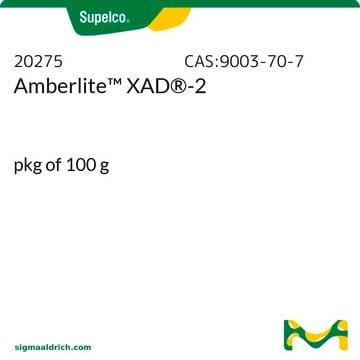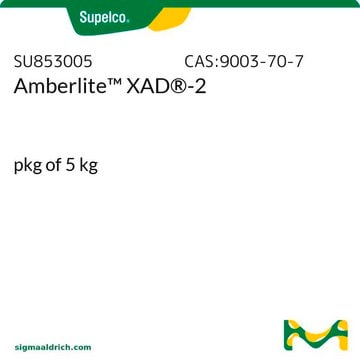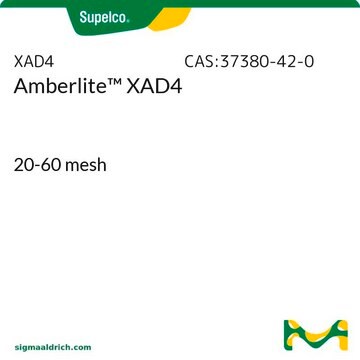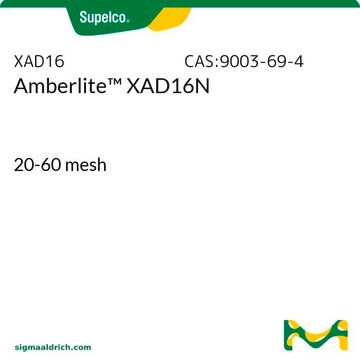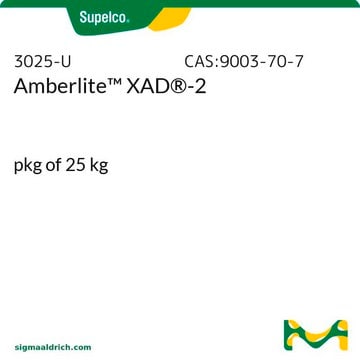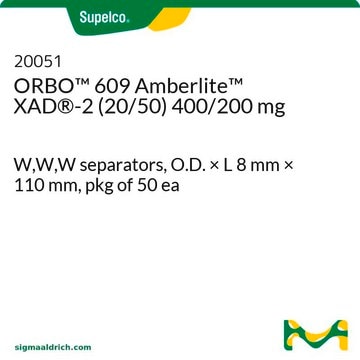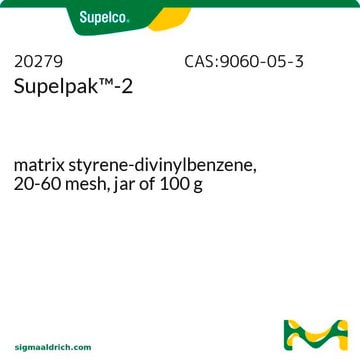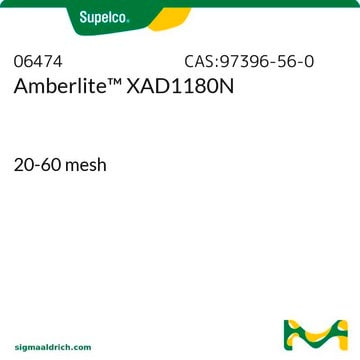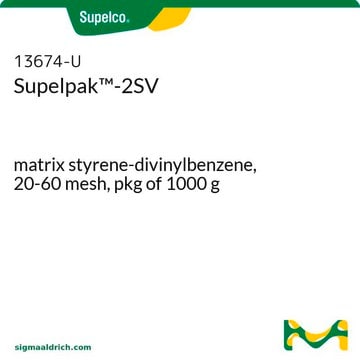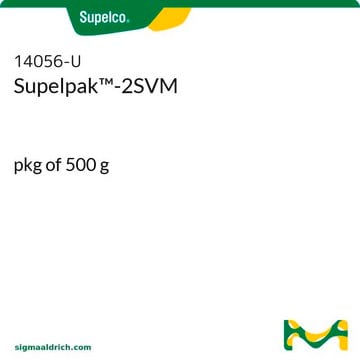If this product has an expiration or retest date, it will be shown on the Certificate of Analysis (COA, CofA). If there is no retest or expiration date listed on the product's COA, we do not have suitable stability data to determine a shelf life. For these products, the only date on the COA will be the release date; a retest, expiration, or use-by-date will not be displayed.
For all products, we recommend handling per defined conditions as printed in our product literature and website product descriptions. We recommend that products should be routinely inspected by customers to ensure they perform as expected.
For products without retest or expiration dates, our standard warranty of 1 year from the date of shipment is applicable.
For more information, please refer to the Product Dating Information document: https://www.sigmaaldrich.com/deepweb/assets/sigmaaldrich/marketing/global/documents/449/386/product-dating-information-mk.pdf
10357
Amberlite™ XAD®-2
pkg of 500 g
About This Item
Produits recommandés
Agence
suitable for ASTM® D4861
suitable for EPA Method 10A, Method 23 and OTM-45
Niveau de qualité
Forme
beads (small)
Conditionnement
pkg of 500 g
Technique(s)
HPLC: suitable
LPLC: suitable
Superficie
~300 m2/g
Matrice
styrene-divinylbenzene (macroreticular)
Groupe de la matrice active
polymer
Taille des particules
20-60 mesh
Dimension de pores
~0.65 mL/g pore volume
90 Å mean pore size
Densité
1.02 g/mL at 25 °C (true wet)(lit.)
1.08 g/mL at 25 °C (skeletal)(lit.)
Technique de séparation
reversed phase
Température de stockage
2-8°C
Chaîne SMILES
N([C@@H](CCC(=O)OC(C)(C)C)C=O)C(=O)OCC1c2c(cccc2)c3c1cccc3
InChI
1S/C24H27NO5/c1-24(2,3)30-22(27)13-12-16(14-26)25-23(28)29-15-21-19-10-6-4-8-17(19)18-9-5-7-11-20(18)21/h4-11,14,16,21H,12-13,15H2,1-3H3,(H,25,28)/t16-/m0/s1
Clé InChI
BCIPGSZQUDLGSY-INIZCTEOSA-N
Vous recherchez des produits similaires ? Visite Guide de comparaison des produits
Catégories apparentées
Description générale
Spécifications :
Application
Informations légales
Produit(s) apparenté(s)
Code de la classe de stockage
11 - Combustible Solids
Classe de danger pour l'eau (WGK)
WGK 3
Point d'éclair (°F)
Not applicable
Point d'éclair (°C)
Not applicable
Équipement de protection individuelle
Eyeshields, Gloves, type N95 (US)
Faites votre choix parmi les versions les plus récentes :
Déjà en possession de ce produit ?
Retrouvez la documentation relative aux produits que vous avez récemment achetés dans la Bibliothèque de documents.
Les clients ont également consulté
Contenu apparenté
La chromatographie liquide basse pression (LPLC) utilise une pompe de faible pression pour pousser une phase mobile dans une colonne.
Low pressure liquid chromatography (LPLC) operates at low pressures, using a pump to drive the mobile phase onto the column.
Les FAS, ou "substances chimiques éternelles", persistent dans l'environnement et présentent des risques pour la santé humaine. Découvrez nos outils de surveillance environnementale pour la quantification des PFAS, qui peuvent aider les chercheurs, les organismes de réglementation et les laboratoires à tester les PFAS.
FAS, or 'forever chemicals,' persist in the environment and pose risks to human health. Discover our environmental monitoring tools for PFAS quantification, aiding researchers, regulators, and labs in testing for PFAS.
-
How can I determine the shelf life / expiration / retest date of this product?
1 answer-
Helpful?
-
-
How is shipping temperature determined? And how is it related to the product storage temperature?
1 answer-
Products may be shipped at a different temperature than the recommended long-term storage temperature. If the product quality is sensitive to short-term exposure to conditions other than the recommended long-term storage, it will be shipped on wet or dry-ice. If the product quality is NOT affected by short-term exposure to conditions other than the recommended long-term storage, it will be shipped at ambient temperature. As shipping routes are configured for minimum transit times, shipping at ambient temperature helps control shipping costs for our customers. For more information, please refer to the Storage and Transport Conditions document: https://www.sigmaaldrich.com/deepweb/assets/sigmaaldrich/marketing/global/documents/316/622/storage-transport-conditions-mk.pdf
Helpful?
-
-
What is the most approriate protocol to wash Amberlite before use? Thanks in advance!
1 answer-
Amberlite XAD-2 is a crude preparation and must be thoroughly cleaned prior to use.
1. Rinse with hot deionized water (may hold in nylon filter cloth to retain particles) - use at least 3 bed volumes per hour at 110 deg C
2. Soak overnight in 2 bed volumes (BV) of ethanol.
3. Load resin into a glass column and rinsed with a further 2 BV of ethanol.
4. Rinse with 2 BV of deionized water to remove the ethanol, 1 BV of 4% (w/v) sodium hydroxide, 2 BV of deionized water, 1 BV 4% (v/v) hydrochloric acid, and finally rinse with deionized water until the pH of the eluent is neutral.For further use it is advantageous to do a wash in the same solvent use in the application.
Store in sealed container; may be refrigerated but NOT frozen. As a bacteriostat, one may rinse with 20% ethanol (deionized water) prior to storage.Helpful?
-
-
What is the Department of Transportation shipping information for this product?
1 answer-
Transportation information can be found in Section 14 of the product's (M)SDS.To access the shipping information for this material, use the link on the product detail page for the product.
Helpful?
-
-
Do you offer a precleaned Amberlite XAD-2?
1 answer-
Yes. Supelco cleans Amberlite XAD2 for a variety of environmental applications.
Helpful?
-
-
May I purchase Amberlite XAD-2 in large quantities?
1 answer-
The largest package size of Amberlite XAD2 is 25 kg (Product No. 3025-U).
Helpful?
-
-
Is Amberlite XAD-2 ready-to-use?
1 answer-
No. Amberlite XAD2 is shipped imbibed with 5% NaCl & 1% NaCO3; it has not been specially processed nor cleaned. We suggest that it be extensively treated to a suitable preliminary elution and wash.
Helpful?
-
Active Filters
Notre équipe de scientifiques dispose d'une expérience dans tous les secteurs de la recherche, notamment en sciences de la vie, science des matériaux, synthèse chimique, chromatographie, analyse et dans de nombreux autres domaines..
Contacter notre Service technique